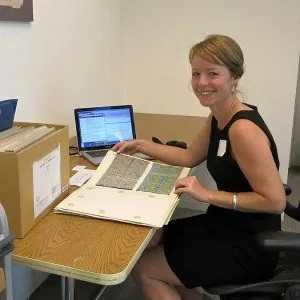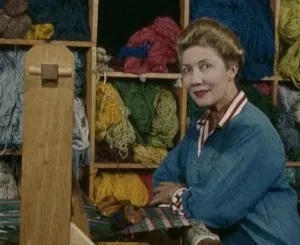Summer Research Report: Sarah Mills

Image courtesy Sarah Mills
This past summer, the Trust was fortunate enough to award two Marie Zimmermann Summer Research Grants for the study of 20th-century American craftspeople and their handiwork. Sarah Mills, a doctoral candidate at the Graduate Center of the City University of New York, received one of these grants to assist her study of weaver Dorothy Liebes.
Hailing from Asheville, North Carolina, Sarah grew up in a region with a long tradition of the handicraft she studies today. A graduate of the University of North Carolina at Ashesville, Sarah has taught at Hunter College, CUNY, and Christie’s, and served as a copy editor and translator for publication houses that include Landmarks50. Her dissertation focuses on the spread of the American school of craft hand-weaving, which rose to popularity around 1930. Although her summer project focused solely on Liebes, her larger investigation covers the wider culture and surviving objects of this weaving tradition, which remains little studied. Many weavers, including Liebes, worked with the great architects and designers of the 20th century, and their textiles became central to the modern aesthetics of the period.

Dorothy Liebes. Image courtesy Wikimedia Commons.
“This summer I pored over numerous swatches woven by Dorothy Liebes housed at the Smithsonian’s Archives of American Art in Washington, DC, in a trip made possible by the Decorative Arts Trust. My dissertation, Craft Consciousness: Modern Weaving in the United States, 1935-1956, considers the mid-century weaver’s work and others in examining how a wave of industrialization and the professionalization of weavers in the field of industrial design impacted the form and meaning of woven objects. My research at the Smithsonian’s archives helped me grasp the extent of Liebes’ experimental studies with modern fibers.
“I focused predominantly on Liebes’ work with synthetic threads, particularly metallic ones known by their brand names Lurex and Fairtex. If you bought a shimmering interior fabric in the 1950s in the United States, there is a good chance that you bought a Dorothy Liebes design. In 1946, the Dobeckmun Company, which was the first to make modern metallic threads, hired Liebes to test their new Lurex fiber in woven swatches. Dobeckmun, under the guidance and sole direction of Liebes, then mass produced specific designs for a mainstream textile market. As a result of her expertise in hand weaving and as a style authority, Liebes held contracts with multiple manufacturing companies, giving her access to an enormous range of natural and innovative artificial fibers. Between the mid-1940s and the late 1950s, she eagerly experimented with metallic threads.
“The organization and diversity of Liebes’ swatches suggest that her weaving studies analyzed color relationships, densities, textures, and performance capabilities. For instance, she constructed charts based on the graduated thicknesses of yarns. She also designed grids where in each cube a multitude of threads reveal a range of value for one specific hue. More elaborate studies occurred on the loom. The differences in texture and density in woven swatches proved telling of Liebes’ concerns in function and the effectivity of fabric intended specifically for automobile upholstery, wall covering, or window drapery.
“Metallic threads, because of their strong mirror-like reflectivity, offered Liebes a profound freedom to play with spatial illusions. Where Liebes used tiny metallic threads sparsely as weft with thicker, fuzzier natural yarns as warp, she created highlights in swatches with considerable illusions of depth. When moving or walking by a fabric with metallic thread, light quickly dashes across the smooth gilt-like surfaces enhancing the sculptural quality of the material’s form. In a way, this approach created the concept of woven fibers as conduits of electricity. That Liebes utilized metallic materials as weft and warp threads also indicates her interests in testing their durability.
“My insights into Liebes’ weaving studies could not have been possible without observing her fabrics first hand. I am grateful to the Decorative Arts Trust and the Marie and John Zimmermann Fund for their support. I hope to continue sharing my research so as to broaden an understanding of modern weaving in the United States.
The Trust echoes Sarah’s gratitude to the Zimmermann Fund, Inc., for their ongoing support of the Trust’s Emerging Scholars Program, and the Summer Research Grants in particular. We are also pleased to announce that Sarah will present her findings during the inaugural Emerging Scholars Colloquium, to be held on January 22nd, following our annual Antiques Weekend program. Co-sponsored by the Classical American Homes Preservation Trust and supported by the Wunsch Americana Foundation, the Colloquium provides Sarah and four of her 2016 Emerging Scholars cohorts to share their exciting new research. Registration opens soon, and we encourage all who can come to New York for the day to hear first-hand the noteworthy results of the Trust’s scholarship program!
About The Decorative Arts Trust Bulletin
Formerly known as the "blog,” the Bulletin features new research and scholarship, travelogues, book reviews, and museum and gallery exhibitions. The Bulletin complements The Magazine of the Decorative Arts Trust, our biannual members publication.









